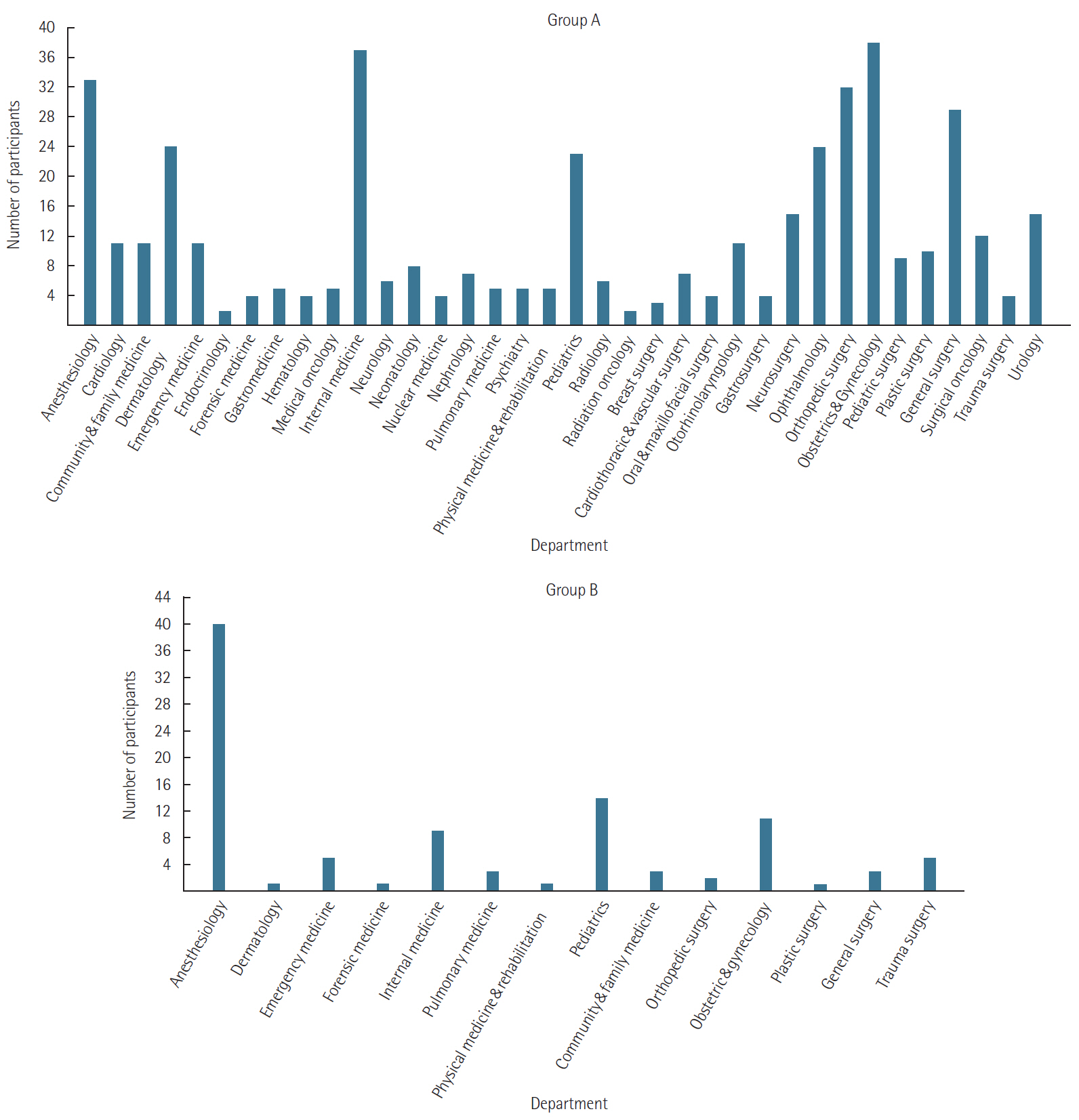Acute Crit Care.
2021 Feb;36(1):54-61. 10.4266/acc.2020.00759.
Effectiveness of online versus in-person structured training program on arterial blood gas, electrolytes, and ventilatory management of critically ill patients
- Affiliations
-
- 1Department of Anesthesiology, All India Institute of Medical Sciences, Rishikesh, India
- 2Department of Pathology, All India Institute of Medical Sciences, Rishikesh, India
- KMID: 2513254
- DOI: http://doi.org/10.4266/acc.2020.00759
Abstract
- Background
Due to the risk of viral transmission during in-person training, a shift toward online platforms is imperative in the current pandemic. Therefore, we compared the effectiveness of an in-person interactive course with a structurally similar online course designed to improve cognitive skills among clinical health professionals in arterial blood gas analysis, management of electrolyte imbalances, and approaches to mechanical ventilation in critically ill patients.
Methods
In an observational, outcome assessor-blinded, cohort trial, group A included participants enrolled prospectively in an online course, while group B included those who took part in an in-person course (retrospective arm). The primary objective was comparison of cognitive skills through a pre and post-test questionnaire. Statistical analysis was performed using Student t-test.
Results
In total, 435 participants were analyzed in group A, while 99 participants were evaluated in group B. The mean pre-test score was 9.48±2.75 and 10.76±2.42, while the mean post-test score was 11.94±1.90 (passing rate, 64.6%) and 12.53±1.63 (passing rate, 73.3%) in groups A and B, respectively. Group B scored significantly higher in both pre-test (P=0.001) and post-test evaluations (P=0.004). The improvement in post-test score was significantly greater (P=0.001) in group A (2.46±2.22) compared to group B (1.77±1.76). The medical specialties fared better in group B, while surgical specialties scored higher in group A. The pre-test vs. post-test scores exhibited a moderate correlation in both groups (P<0.001). The feedback survey showed a Likert score >3.5 for most points in both groups.
Conclusions
The online teaching module exhibited a significant benefit in terms of participant sensitization and knowledge sharing.
Keyword
Figure
Reference
-
1. Cucinotta D, Vanelli M. WHO declares COVID-19 a pandemic. Acta Biomed. 2020; 91:157–60.2. World Health Organization. Considerations in adjusting public health and social measures in the context of COVID-19. Geneva: World Health Organization;2020.3. Hayes CW, Rhee A, Detsky ME, Leblanc VR, Wax RS. Residents feel unprepared and unsupervised as leaders of cardiac arrest teams in teaching hospitals: a survey of internal medicine residents. Crit Care Med. 2007; 35:1668–72.
Article4. Jain G, Gupta B, Gupta P, Rao S. Online training for sensitisation on airway and ventilatory management as preparedness to combat COVID situation. Indian J Anaesth. 2020; 64:919–20.
Article5. Joyce MF, Berg S, Bittner EA. Practical strategies for increasing efficiency and effectiveness in critical care education. World J Crit Care Med. 2017; 6:1–12.
Article6. Richmond H, Copsey B, Hall AM, Davies D, Lamb SE. A systematic review and meta-analysis of online versus alternative methods for training licensed health care professionals to deliver clinical interventions. BMC Med Educ. 2017; 17:227.
Article7. Sabri N, Sun NZ, Cummings BA, Jayaraman D. The perceived effect of duty hour restrictions on learning opportunities in the intensive care unit. J Grad Med Educ. 2015; 7:48–52.
Article8. Gupta B, Jain G, Mishra P, Pathak S. Preparedness to combat COVID-19 via structured online training program regarding specific airway management: a prospective observational study. Indian J Anaesth. 2020; 64:796–9.
Article9. Cowan N. George Miller’s magical number of immediate memory in retrospect: observations on the faltering progression of science. Psychol Rev. 2015; 122:536–41.
Article10. Patterson MD, Geis GL, Falcone RA, LeMaster T, Wears RL. In situ simulation: detection of safety threats and teamwork training in a high risk emergency department. BMJ Qual Saf. 2013; 22:468–77.
Article11. Sajeva M. E-learning: web-based education. Curr Opin Anaesthesiol. 2006; 19:645–9.
Article12. Pei L, Wu H. Does online learning work better than offline learning in undergraduate medical education? A systematic review and meta-analysis. Med Educ Online. 2019; 24:1666538.
Article13. Ehrlich H, McKenney M, Elkbuli A. Protecting our healthcare workers during the COVID-19 pandemic. Am J Emerg Med. 2020; 38:1527–8.
Article
- Full Text Links
- Actions
-
Cited
- CITED
-
- Close
- Share
- Similar articles
-
- Comparison of Na, K between arterial whole blood and venous serum electrolyte analyzer: For clinical use of arterial whole blood analysis of electrolytes
- Changes of anion gap, serum electrolytes, and arterial blood gas analysis associated with hypoalbuminemia
- Arterial Blood Lactate Concentrations as a Prognostic Predictor in Critically Ill Patients: in Comparison with APACHE II Scores
- Effects of different sample volumes on arterial blood gas and electrolytes testing
- Comparison of Conventional Chiron 348 pH/blood Gas/electrolytes Analyzer and i-STAT Portable Clinical Analyzer



